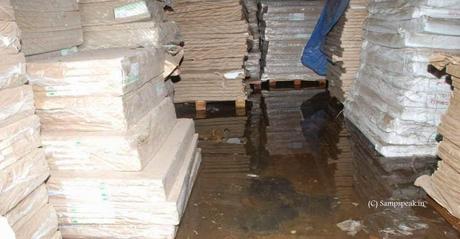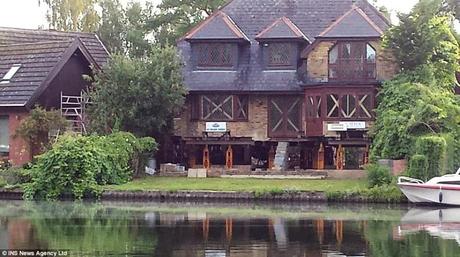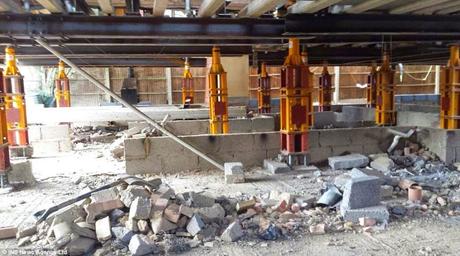 A ‘
flood ’ is an overflow of water that submerges land which is
usually dry. The European Union (EU) Floods Directive defines a flood as a
covering by water of land not normally covered by water. Flooding may occur as
an overflow of water from water bodies, such as a river or lake, in which the
water overtops or breaches its confinement, resulting in some of that water escaping its
usual boundaries. Floods can also occur
in rivers when the flow rate exceeds the capacity of the river channel,
particularly at bends or meanders in the waterway. Floods often cause damage to
homes and businesses if they are in the natural flood plains of rivers. Some floods develop slowly, while others such
as flash floods, can develop in just a few minutes and without visible signs of
rain.
Additionally,
floods can be local, impacting a neighbourhood or community, or very large,
affecting entire river basins. In some cities, new colonies get flooded and
marooned because houses get constructed in places which were once bunds and
lakes. Flood is a peril that can be
insured against. Presently, in India, we have the ‘Standard Fire & Special
Perils Policy” .. which provides indemnity for named perils and the perils
named in the Policy are : Fire; Lightning; Explosion/Implosion; Aircraft damage; Riot, Strike & Malicious damage; Impact damage; Subsidence and Landslide;
bursting and /or overflowing of water tanks; missile testing operations;
leakage from automatic sprinkler installations; bush fire and …… wind and water
perils named as “ Storm, cyclone, typhoon, tempest, hurricane, tornado, flood
and inundation. ”
The ‘wind and water perils’ – elaborately
described as ‘Storm, cyclone, typhoon, tempest, hurricane, tornado, flood and
inundation’ are part of Insurance coverage, without payment
of any additional premium. However for covering ‘Earthquake’ additional
premium will have to be paid. In our
policies, the flood is not defined and for wind perils, universally reference
is drawn to ‘Beaufort scales’. In
Australia, ‘flood’ as stated in Insurance policies – purported to mean ‘the
covering of normally dry land by water that has escaped or been released from
the normal confines of...a lake, a river, a creek or another natural
watercourse a reservoir, a canal or dam.
There
are flood prone areas and in India, Insurers tend to avoid such bad risks. In US, there are codified flood-hazard maps
which helps determine the hazard exposure and type of flood insurance coverage one
will need since standard homeowners insurance doesn't cover flooding. The lower the degree of risk, the lower the
flood insurance premium. To reiterate,
in US and in many other places, Standard home policy or Fire Policy does not
cover flooding. In USA, way back in 1968,
Congress created the National Flood Insurance Program (NFIP) to help provide a
means for property owners to financially protect themselves. The NFIP offers
flood insurance to homeowners, renters, and business owners if their community
participates in the NFIP. In Mar 2014, President
Obama signed the Homeowner Flood Insurance Affordability Act of 2014 into law.
Back home, even
when insured, the policy holder is expected to prudent. In flood areas, Risk Managers would advise to
keep stocks well above the expected flooding levels. Goods should be stacked on racks and kept a
few feets above the ground level and not left on grounds. Here is an interesting newsitem from
MailOnline on what a family of Berkshire did !
Yaron
Ivry and his family live in five-bedroom home on an island between water
channels in Wraysbury, Berkshire. Their
house was gutted by floods last January when many of his neighbours couldn't
return home. In bid to beat the frequent flooding, the family have spent three
months and £80,000 lifting the house on to stilts. After the work raised the
house five feet off ground, experts estimate it's now worth up to £2 million.
It is
the news of determined couple whose
island home was wrecked when the Thames burst its banks last year have come up
with a new idea - shifting their five-bedroom house 5ft into the air. Yaron
Ivry and his wife Sigal have spent almost £80,000 jacking their riverside
property in Wraysbury, Berkshire, up onto stilts, and filling in the gap with
breeze blocks. Over the course of ten days, a team of engineers lifted the
80-ton building up into the air, using a steel cradle and 28 computerised jacks
which pushed the house upwards at a rate of three inches an hour. Now, a year
after the house was devastated by floods last January, work is complete with
the house protected from the waters of the Thames, and the Ivry family enjoying
a new basement underneath their home, as well as a new kitchen, replacing the
one which was left underwater when the river breached its banks.
A ‘
flood ’ is an overflow of water that submerges land which is
usually dry. The European Union (EU) Floods Directive defines a flood as a
covering by water of land not normally covered by water. Flooding may occur as
an overflow of water from water bodies, such as a river or lake, in which the
water overtops or breaches its confinement, resulting in some of that water escaping its
usual boundaries. Floods can also occur
in rivers when the flow rate exceeds the capacity of the river channel,
particularly at bends or meanders in the waterway. Floods often cause damage to
homes and businesses if they are in the natural flood plains of rivers. Some floods develop slowly, while others such
as flash floods, can develop in just a few minutes and without visible signs of
rain.
Additionally,
floods can be local, impacting a neighbourhood or community, or very large,
affecting entire river basins. In some cities, new colonies get flooded and
marooned because houses get constructed in places which were once bunds and
lakes. Flood is a peril that can be
insured against. Presently, in India, we have the ‘Standard Fire & Special
Perils Policy” .. which provides indemnity for named perils and the perils
named in the Policy are : Fire; Lightning; Explosion/Implosion; Aircraft damage; Riot, Strike & Malicious damage; Impact damage; Subsidence and Landslide;
bursting and /or overflowing of water tanks; missile testing operations;
leakage from automatic sprinkler installations; bush fire and …… wind and water
perils named as “ Storm, cyclone, typhoon, tempest, hurricane, tornado, flood
and inundation. ”
The ‘wind and water perils’ – elaborately
described as ‘Storm, cyclone, typhoon, tempest, hurricane, tornado, flood and
inundation’ are part of Insurance coverage, without payment
of any additional premium. However for covering ‘Earthquake’ additional
premium will have to be paid. In our
policies, the flood is not defined and for wind perils, universally reference
is drawn to ‘Beaufort scales’. In
Australia, ‘flood’ as stated in Insurance policies – purported to mean ‘the
covering of normally dry land by water that has escaped or been released from
the normal confines of...a lake, a river, a creek or another natural
watercourse a reservoir, a canal or dam.
There
are flood prone areas and in India, Insurers tend to avoid such bad risks. In US, there are codified flood-hazard maps
which helps determine the hazard exposure and type of flood insurance coverage one
will need since standard homeowners insurance doesn't cover flooding. The lower the degree of risk, the lower the
flood insurance premium. To reiterate,
in US and in many other places, Standard home policy or Fire Policy does not
cover flooding. In USA, way back in 1968,
Congress created the National Flood Insurance Program (NFIP) to help provide a
means for property owners to financially protect themselves. The NFIP offers
flood insurance to homeowners, renters, and business owners if their community
participates in the NFIP. In Mar 2014, President
Obama signed the Homeowner Flood Insurance Affordability Act of 2014 into law.
Back home, even
when insured, the policy holder is expected to prudent. In flood areas, Risk Managers would advise to
keep stocks well above the expected flooding levels. Goods should be stacked on racks and kept a
few feets above the ground level and not left on grounds. Here is an interesting newsitem from
MailOnline on what a family of Berkshire did !
Yaron
Ivry and his family live in five-bedroom home on an island between water
channels in Wraysbury, Berkshire. Their
house was gutted by floods last January when many of his neighbours couldn't
return home. In bid to beat the frequent flooding, the family have spent three
months and £80,000 lifting the house on to stilts. After the work raised the
house five feet off ground, experts estimate it's now worth up to £2 million.
It is
the news of determined couple whose
island home was wrecked when the Thames burst its banks last year have come up
with a new idea - shifting their five-bedroom house 5ft into the air. Yaron
Ivry and his wife Sigal have spent almost £80,000 jacking their riverside
property in Wraysbury, Berkshire, up onto stilts, and filling in the gap with
breeze blocks. Over the course of ten days, a team of engineers lifted the
80-ton building up into the air, using a steel cradle and 28 computerised jacks
which pushed the house upwards at a rate of three inches an hour. Now, a year
after the house was devastated by floods last January, work is complete with
the house protected from the waters of the Thames, and the Ivry family enjoying
a new basement underneath their home, as well as a new kitchen, replacing the
one which was left underwater when the river breached its banks.
 Mr
Ivry hired specialist builders who created a network of steel beams under the
house which would hold its weight as the property began to lift. Holes were
bored into the brick walls, so supportive beams could put up both inside and
outside the building. 28 super-strong
jacks — each capable of supporting 50 tons — were placed underneath the steel
cradle. A diamond-edged saw then sliced horizontally through all the brick
walls below the level of the concrete floors, severing the building from its
foundations.
Mr
Ivry hired specialist builders who created a network of steel beams under the
house which would hold its weight as the property began to lift. Holes were
bored into the brick walls, so supportive beams could put up both inside and
outside the building. 28 super-strong
jacks — each capable of supporting 50 tons — were placed underneath the steel
cradle. A diamond-edged saw then sliced horizontally through all the brick
walls below the level of the concrete floors, severing the building from its
foundations.
 With the perimeter ring of
steel steadying the structure and pressure spread evenly over the hydraulic
jacks, no one part of the building was exposed to particular stress as it was
lifted from the ground at a rate of three inches an hour. The
newly-formed gap at the bottom of the house was then filled with breeze blocks,
and the steel cradle removed before the breeze block basement was concealed
with reclaimed London yellow bricks, designed to match the rest of the
house. Mr Ivry's newly-raised front door
now has a long staircase leading up to it, protecting the entrance to the house
from any flood water.
The
value of the house - which had been worth £1 million - dropped to £750,000 as
it could not be insured against future floods. Now, after the £80,000 project
the house is thought to be worth between £1.5 million and £2 million and
Insurers are willing to cover the property at nominal rates. Now everyday as
they look out of the window, they smile and are happy !
With regards – S.
Sampathkumar
With the perimeter ring of
steel steadying the structure and pressure spread evenly over the hydraulic
jacks, no one part of the building was exposed to particular stress as it was
lifted from the ground at a rate of three inches an hour. The
newly-formed gap at the bottom of the house was then filled with breeze blocks,
and the steel cradle removed before the breeze block basement was concealed
with reclaimed London yellow bricks, designed to match the rest of the
house. Mr Ivry's newly-raised front door
now has a long staircase leading up to it, protecting the entrance to the house
from any flood water.
The
value of the house - which had been worth £1 million - dropped to £750,000 as
it could not be insured against future floods. Now, after the £80,000 project
the house is thought to be worth between £1.5 million and £2 million and
Insurers are willing to cover the property at nominal rates. Now everyday as
they look out of the window, they smile and are happy !
With regards – S.
Sampathkumar
13th Feb 2015.

